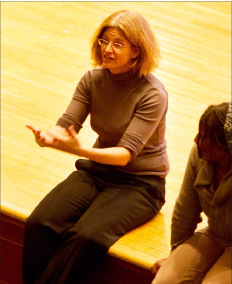
By Devin Loring
Correspondent
Thursday’s Brown Bag Series in the Mildred and Ernest E. Mayo Concert Hall was an intimate affair, with a handful of people present to watch a documentary about a surplus of “things.”
The event showcased independent producer and filmmaker Kelly Anderson’s documentary, “Never Enough,” about a topic that has recently been gaining national popularity — hoarding. The topic is the central focus of such series as TLC’s “Hoarding: Buried Alive” and A&E’s “Hoarders.”
Anderson, who is also a professor at Hunter College, didn’t make this documentary to jump on the hoarding bandwagon, however.
“When I started (making this film) there were no A&E shows about hoarding or anything like that,” Anderson said. “I just felt like there was something wrong.”
The documentary introduced three subjects who all had problems getting rid of their “stuff.”
One of the subjects, Michele Gitlin, owned 700 sweaters and 2,000 men’s ties, according to the documentary’s website.
“I collect anything … but I don’t collect junk,” Gitlin said in the film.
David Guess, another of the film’s participants, was an extreme collector. He owned more than 7,800 Beanie Babies.
All of the participants in the film had at least one thing in common: Ron Alford, founder and director of Disaster Masters, a crisis management organization, was called to help them relinquish their stuff. Alford, a self-styled life coach, has been helping hoarders unclutter their lives since 1985, according to his website, ronalford.theplan.com.
“I don’t know if Ron is a genius or a charlatan,” Anderson said.
Alford would go into the participants’ homes and start throwing their belongings in trash bags. From a viewer’s standpoint, it appeared to be a rather harsh method of helping people with a serious problem let go of their possessions.
One participant, Jay Helfenbein, was mortified when Alford proceeded to throw away a broken blade from his ceiling fan as he contested that it was not garbage.
Helfenbein was a compulsive home shopper, ordering things that he just “had to have” from home shopping networks.
Anderson said, “I was fascinated by the consumer aspect of (hoarding),” which is one of the reasons she decided to make the film in the first place.
In all, this documentary was a bona fide “labor of love,” according to Anderson. It took her about five years to make with a budget of only $14,000.
“It’s harder to get (films) out to everyone (these days). Now it’s about finding your audience,” she said.
Michelle Davies, a sophomore communication studies major, was one of the few students that attended the event.
“I think the film really captured (the participants’) internal struggle with the items they owned and how it affected them,” Davies said. “It was a really well-written story that showcased the hidden aspects of society — hoarding.”
“Never Enough” is the winner of the Artistic Excellence Award from the Big Sky film festival. It is currently available for purchase at neverenoughdocumentary.com.






